When Irish novelist JJ Toner was interviewed for this How I Do It spot on the blog recently, one of the three things he stated that he wished he'd known when he started self-publishing was “the three-act structure of a novel”. It seems he set us all thinking about that one, because English novelist and non-fiction John Lynch picked up that thread and ran with it on our members-only Facebook group, asking and then answering his own question about the narrative arc.
When I sold my first story to BBC Radio 4 Morning Story in 1989, the producer said what a perfect narrative arc and of course I gave a “Well, I should hope so” response, but inside I was thinking, “Eh? I wonder how that happened.”
More recently I would have said I had total mastery of the subject, until I was asked to explain it – and failed. The failure was along the lines of, “Well, it isn't JUST like that,” and “What I should probably have added…”
So I've now tried to define it in simple terms for a keen reader who is not a writer.
The Definition of a Narrative Arc
In a short story of, say, 5,000 words, the narrative arc is very simple. It can be summed up in the well-known story idea:
Boy gets Girl; Boy loses Girl; Boy gets Girl back
There is an objective (in this case, the boy wants to win the girl); there is an obstacle serious enough to make it look as though the objective will not be achieved; the obstacle is overcome and the objective successfully attained.
In a story of only 5,000 words, there’s probably only room for one obstacle; in a full-length novel of 90,000 words, there are likely to be several obstacles, increasing in difficulty, until the last one is finally put away and the book ends with what used to be known to writers as an HEA (Happy Ever After) but, in today’s rather more realistic times, has mostly become HFN (Happy For Now).
In either case – short story or full-length novel – what we have is a curve rising to a peak (Boy gets Girl), then dropping (Boy loses Girl), then rising once more (Boy gets Girl Back).
Not Just for Novels: The Three-Act Play
The narrative arc is not confined to stories and novels; a well-known version covers the three-act play.
Act One sets the scene by introducing the characters and the background. At this point, we learn what the ultimate objective is to be. What is known as an “inciting event” occurs, and that is what starts the story on its journey. The inciting event presages, prefigures, or actually starts a conflict, and the theme of the play will be the working out and settling of that conflict.
In Act Two, the protagonist (the main character) tries to solve the conflict, but it isn’t so easy. (If it were, there would be no story worth following and no play worth watching). A number of obstacles are put in the way of the protagonist, and it is important from the dramatic point of view that at least some of those obstacles have to do with flaws and weaknesses in the protagonist’s personality. (Think of Hamlet’s indecisiveness, or Macbeth’s failure to deal with his wife’s overwhelming ambition. Think also of the way that, when destiny calls, Prince Hal turns his back on Falstaff, and it will become clear why, of these three (Hamlet, Macbeth, and the prince), only the latter is a genuine hero). The obstacles become bigger and, if the play or novel is a good one, the protagonist comes close to being defeated. That is the moment when the protagonist makes a decision (often a moral one) to take us into Act Three.
In that last act, two important things happen: the story reaches its final peak, or climax, and the protagonist undergoes a profound change of some kind. In all the best stories, what makes both the change and the climax possible is an inner strength that the protagonist has found that makes it possible to solve a problem that could not be solved before. Or, of course, the character fails and meets a tragic end, but the change is still accomplished.
OVER TO YOU I'd be grateful to have holes picked in my defintion (by anyone), bearing in mind that this is intended for a keen reader who is not a writer. So comment away!
#Authors - do you agree with @JLynchAuthor's definition of a narrative arc? Share on XRELATED POSTS







Do a search on – Blake Snyder Save the Cat beat sheet. He lays out this same story structure, except with some additional beats that help connect all the dots. It’s a version of Campbell’s hero’s journey, so of course it has universal application.
Another version is in Dan Harmon’s Story Circle.
Thanks for sharing John.
The three act play also works well for historical fiction, perhaps because it has that feel of sagas and Shakespearean drama. I recently found some headings to break down the 3 acts as follows (and used them to write my synopses):-
Act 1: Beginning
– ordinary world
– inciting incident
– climax/turning point
Act 2: Middle
– rising action/obstacles/try-fail cycles
– midpoint
– turning point/dark night of the soul!
Act 3: End
– climax
– denouement/return to real world/round-up
This is effectively what you have described and I would agree it works very well for me. My novels contain saga-esque journeys and rights of passage, which fit snugly into the 3-act scenario. You can layer with multiple sub-plots too.
I like to call it:
Act 1: Oh no, something terrible is happening!
Act 2: Holy crap, this is worse than we thought!
Act 3: Wait, I think I know how to fix this!
[…] Writing: The Narrative Arc and the Three-Act Novel […]
Thanks John for turning your previous comment into a blog. Really useful. I am in the midst of a plot with 4 strands … hopefully this will help in keeping the basic structure going for the main character (s)! It’s a bit more difficult the less one is writing truly ‘genre’ fiction I think. (Boy may meet and also lose girl, or vice versa, but how to arc the other elements? Sometimes you need to! Multi-arc?! :-))
Dan Holloway, I also like you further thoughts on this one!
It’s a structure that works very efficiently in many genres. I’ve seen accounts where Act Two represents an internal quest as the protagonist goes on a journey of self-discovery in new surroundings before the fulcrum event that launches them, with this changed self-knowledge, onto an external quest – that seems to me to work very well for YA fiction where it is employed a lot in the “entering a new world” type book.
A variant that works really well for thrillers is turning that inside/outside a little to mean “inside the law”/”outside the law” so that we have the character believing they can overcome the main obstacle by conventional means and then realising they can’t and going rogue – it’s a way of avoiding the “why didn’t they just dial 911?” complaint as well as allowing, as with the YA version, for a lot of self-discovery – usually a growing realisation that the world is a darker place than they thought.